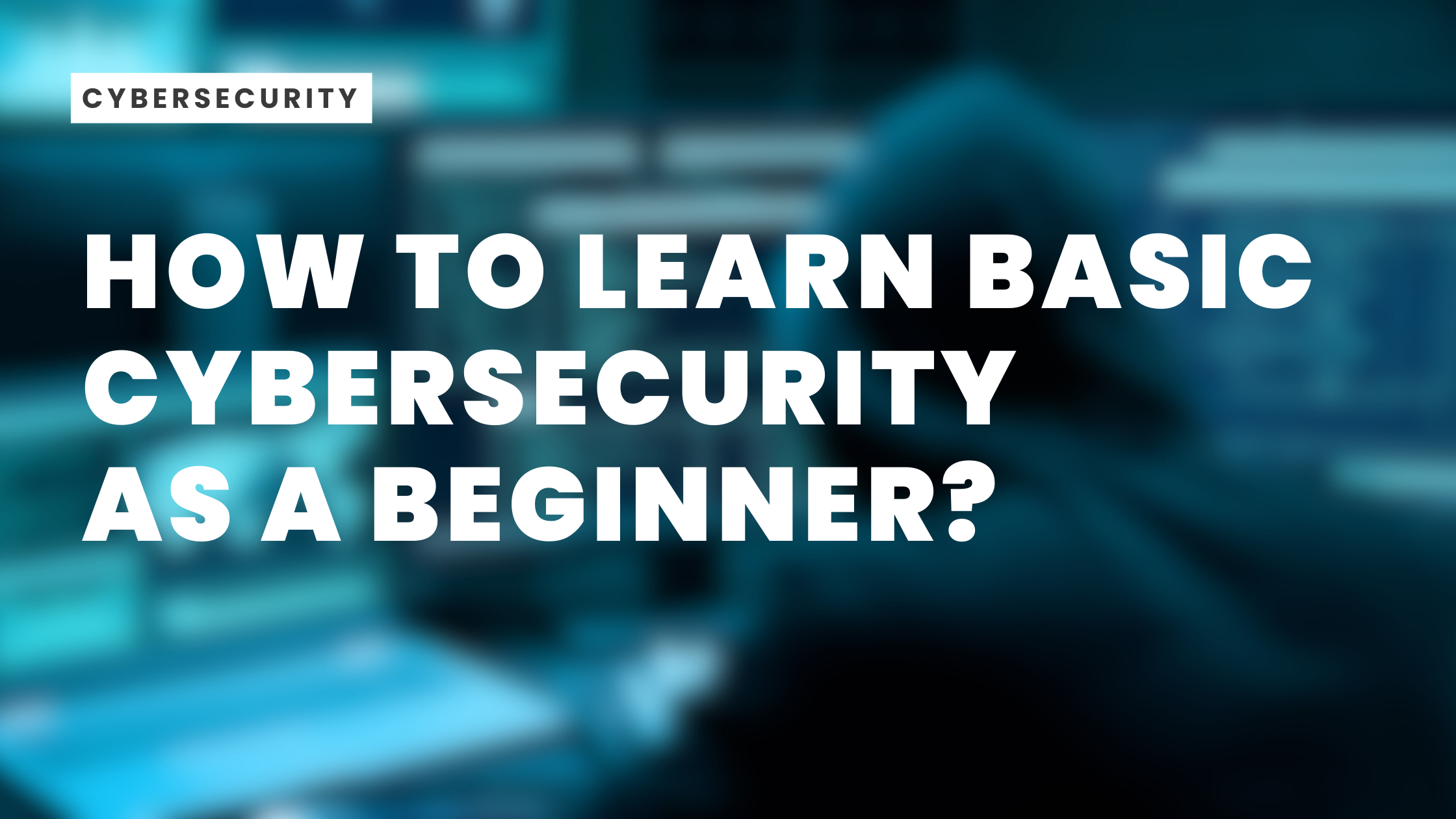How to Learn Basic Cybersecurity as a Beginner?
Our lives are so intertwined with digital networks that cybersecurity has become a necessity, not a luxury. It's crucial for everyone, from individuals safeguarding personal data to large corporations protecting sensitive information.
But don't hit the panic button just yet! This comprehensive guide is here to help you understand the basics and strengthen your online defense.
Key Takeaways
- Cybersecurity is about safeguarding systems, networks, and personal data from cyber attacks. For this, we use technology, processes, and controls. It's important for everyone to understand the basics to protect their online presence.
- The CIA Triad, which stands for Confidentiality, Integrity, and Availability, is at the core of cybersecurity. Knowing cybersecurity terms like encryption and network protocols is also crucial.
- Our personal devices and online activities need protective measures. These include antivirus software, two-factor authentication, VPNs, and encryption.
1. Cybersecurity Basics for Beginners
Cybersecurity is all about protecting systems, networks, and data from cyber threats. It's a must-have in today's digital age, where data breaches and cyber attacks are commonplace. Here's a quick overview:
What is cybersecurity? It's the practice of safeguarding systems, networks, and data from digital attacks. It's essential for everyone connected to the internet.
Why is it important? Cybersecurity protects not just big companies, but also individuals. It's about defending your personal data and devices against cyber threats.
How does it work? Cybersecurity uses a mix of technology, processes, and controls. It helps to prevent unauthorized access to systems, networks, and data.
What are the basics? Understanding core principles like system development security and database security models can help to defend your networks and secure your data.
Don't let the complexity of cybersecurity intimidate you. By learning the basics, you can take the first step towards protecting your digital presence.
2. The CIA Triad
The CIA Triad is a crucial concept in cybersecurity. It stands for:
Confidentiality: This means that only authorized people can access sensitive data.
Integrity: This ensures that only authorized people can change sensitive data, keeping it accurate and trustworthy.
Availability: This means that data should be easily accessible to those who need it, when they need it.
3. Cybersecurity Language Explained
As a cybersecurity beginner, you'll encounter many new terms. Understanding these terms is crucial for navigating the cybersecurity world. Here are some key ones:
Encryption: This is the process of converting plain text into coded form or 'ciphertext' using an encryption algorithm. It's a vital security measure for keeping data confidential when transmitted over networks.
Decryption: This is the process of turning ciphertext back into its original plain text form, allowing the intended recipient to read the information.
DHCP: This assigns an IP address to each device that connects to the internet, ensuring smooth communication.
DNS: This translates domain names into IP addresses, allowing users to access websites using names instead of numerical IP addresses.
Bot: This is a software program that can control a computer without the user's knowledge, often used for malicious activities.
4. Basic Steps to Protect Your Digital Assests
Understanding cybersecurity terms is just the start. Let's see how to apply this knowledge to protect your digital assets. Here's a simplified guide to securing your devices and online activities.
Keeping Your Devices Safe
Your devices are the gateway to your digital world. Here's how to protect them:
Use a reliable anti-virus program.
Use an anti-malware program.
Use two-factor authentication for extra security.
Remember to keep your devices and software updated regularly. These updates often include important security fixes.
Protecting Your Online Activities
Your online activities need protection too. Here's how to do it:
Use a Virtual Private Network (VPN) to secure your internet connection and hide your IP address.
Use encryption to secure your data.
Remember, you also need to be cautious when browsing and clicking on links. Some links may be malicious and compromise your data security and privacy.
5. Common Cyber Attacks
Malware Attacks: These are harmful software like ransomware, clickjacking, and cryptocurrency hijacking. Their goal is to damage or gain unauthorized access to your system.
Phishing: Attackers use emails, instant messages, or texts to trick you into clicking malicious links or revealing sensitive information. They pretend to be legitimate entities to gain your trust.
Password Attacks: Here, attackers aim to decrypt your password and gain unauthorized access to your accounts.
Distributed Denial of Service (DDoS) Attacks: In this attack, a server is flooded with traffic from a network of bots. This makes the website or service inaccessible to legitimate users due to the overwhelming traffic.
6. Simple Security Habits for Everyone
People are the first line of defense in cybersecurity. The right knowledge and habits can protect against most cyber threats. Here's a quick guide to everyday security:
Email and Social Media Safety
Be cautious with all emails.
Use multifactor authentication.
Regularly update software and email clients.
Use unique, strong passwords for email accounts.
Be extra careful with emails or social media messages from unknown senders or with unexpected requests. They might be traps!
The Importance of Email Encryption
Encrypting emails is a good way to protect sensitive data. It makes sure only the intended recipient can read the email.
Disaster Recovery and Incident Response
Have a plan ready in case of a cyber attack. A good disaster recovery plan helps an organization:
Bounce back from disruptions like cyber attacks or natural disasters.
Restore critical systems and data.
Minimize downtime and protect valuable information.
An incident response plan is just as important. It helps manage cyber attacks by quickly identifying and containing the attack, reducing damage and recovery time.
7. Cybersecurity Careers and Certifications
The cybersecurity field offers various roles and certifications to those interested. Here's a quick rundown:
Cybersecurity Analysts: They manage security controls and perform assessments.
Cloud Security Engineers: They handle the security of cloud-based systems.
The tech industry's rapid growth and increasing digital threats have resulted in a high demand for skilled cybersecurity professionals. Some valuable certifications in the field include:
Certified Ethical Hacker (CEH): This certification demonstrates proficiency in ethical hacking and penetration testing.
ISACA’s CISM and CISA Certifications: These are highly valued in the cybersecurity industry.
8. Access Management and Physical Security Management Practices
Access Management: In cybersecurity, controlling who can access what is crucial. Access management helps organizations regulate user access to systems and data. It's a key defense against data breaches, malware attacks, and unauthorized access. Key practices in access management include:
Implementing user authentication
Enforcing least privilege
Regularly auditing user access
Physical Security: This involves protecting the physical assets that support digital systems. It prevents unauthorized access to places where data is stored, reducing the risk of physical theft or tampering. Essential practices in physical security include:
Securing the premises
Controlling access to restricted areas
Installing surveillance systems
9. Advanced Cybersecurity Concepts
Ready to dive deeper into cybersecurity? Here are some advanced concepts and protocols:
Threat Intelligence: Understanding potential threats to enhance security.
Intrusion Detection and Prevention Systems (IDPS): Systems that detect and prevent intrusions.
Security Information and Event Management (SIEM): Tools for managing security information and events.
Penetration Testing: Techniques to test system vulnerabilities.
Cryptography: Methods for securing communication.
Secure Software Development: Practices to develop secure software.
Cloud Security: Measures to protect data in the cloud.
Incident Response: Plan to handle cybersecurity incidents.
Machine Learning and Artificial Intelligence (AI): Their role in enhancing cybersecurity.
Zero Trust Architecture: A security model that requires verification for every access request.
Cybersecurity Protocols
These are some key network security protocols:
Internet Protocol Security (IPSec), Virtual Private Networks (VPNs), Secure Sockets Layer (SSL), Transport Layer Security (TLS): Protocols for secure network communication.
SSH File Transfer Protocol (SFTP), Pretty Good Privacy (PGP), Simple Mail Transfer Protocol (SMTP): Application layer protocols for secure data transfer.
10. Summary
Learning cybersecurity basics isn't as scary as it sounds. It's all about understanding key concepts like the CIA Triad, taking basic security measures, and being careful online. Remember, the cybersecurity field is big and always changing, providing endless chances to learn and advance.
10. Frequently Asked Questions
What are the basics of cyber security?
The basics of cyber security include asset management, risk management, access management, threat management, security controls, disaster recovery, incident management, and security education, training, and awareness. Protecting your files and devices is also crucial in maintaining cyber security.
How can I learn cyber security with no experience?
You can start with an online course and familiarize yourself with the fundamentals of cybersecurity. Take advantage of online resources and consider pursuing a certification to gain practical experience in the field.
What is the CIA Triad in cybersecurity?
The CIA Triad in cybersecurity stands for Confidentiality, Integrity, and Availability, representing the fundamental principles of computer security. It focuses on ensuring the security of data and systems.
How can I protect my personal devices from cyber threats?
To protect your personal devices from cyber threats, install anti-virus and anti-malware programs, enable two-factor authentication, and keep your devices and software updated. These steps will greatly enhance your security.
What are some common types of cyber attacks?
Cyber attacks often include malware, phishing, password, and DDoS attacks. These are some common types of cyber attacks to be aware of.









